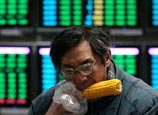
MORE INTERRELATED U.S., CHINESE MARKETS
It is not hard to understand the growing impact of China and the Chinese market on the U.S. and other markets as the world's second largest economy is emerging as a major economic power.
"Traditionally, the U.S. markets have always driven behavior around the globe. I think that has changed somewhat over the last 10 years as the Chinese market and economy have become such a bigger part of what we do globally," Bliss said.
"There are too many interrelationships between the two countries' economies ... We may have political, cultural and ideological differences, but from an economic standpoint, the two countries are coming together very quickly," he added.
However, China is not a sole fundamental factor that will impact the U.S. market. Looking back on the U.S. market's massive run at the beginning of this year, it is fair to say the U.S. market is largely driven by the Fed's stimulus and improving fundamentals of the U.S. economy.
Volatility on the U.S. market spiked after Fed Chairman Ben Bernanke said in a testimony before Congress on May 22 that the Fed may start scaling back asset purchases in the next few meetings. The CBOE Volatility Index, a gauge widely used to measure investor anxiety, has soared over 50 percent since then.
"The U.S. market is trading based upon Fed's behavior and will react to noises coming out of the Fed," Bliss said.
The market's Fed-driven character was partially revealed when it recouped some of the losses on Monday morning following several Fed officials' dovish comments.
Dallas Fed President Richard Fisher said Monday that he was not "in favor of going from wild turkey to cold turkey overnight," when commenting on the Fed tapering policy. While Minneapolis Fed President Narayana Kocherlakota said it was a misperception to view the central bank as more hawkish in its views on scaling back quantitative easing.
In addition, New York Fed President William Dudley said Monday the U.S. monetary policy, though aggressive by historic standards, was not sufficiently accommodative relative to the state of the economy.




















![]()
